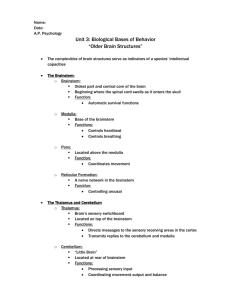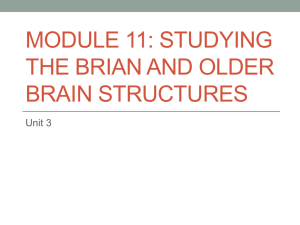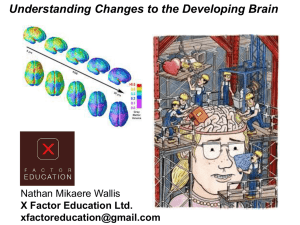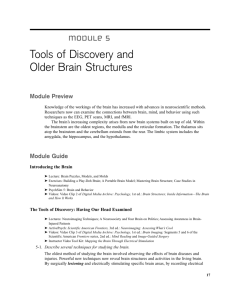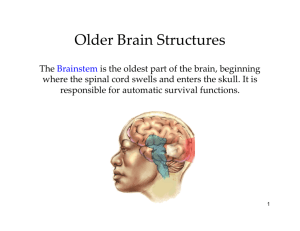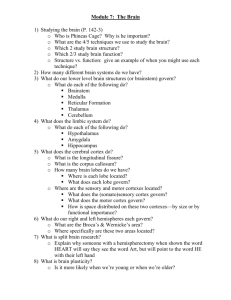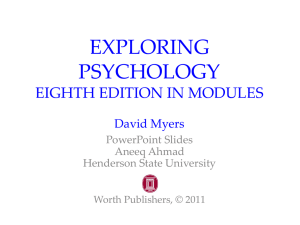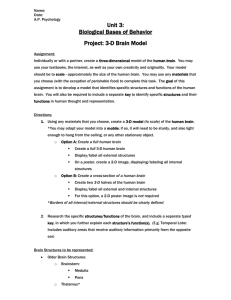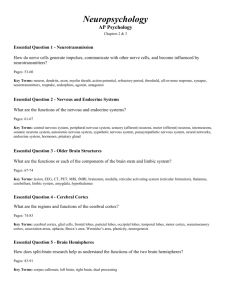Your Brain
advertisement
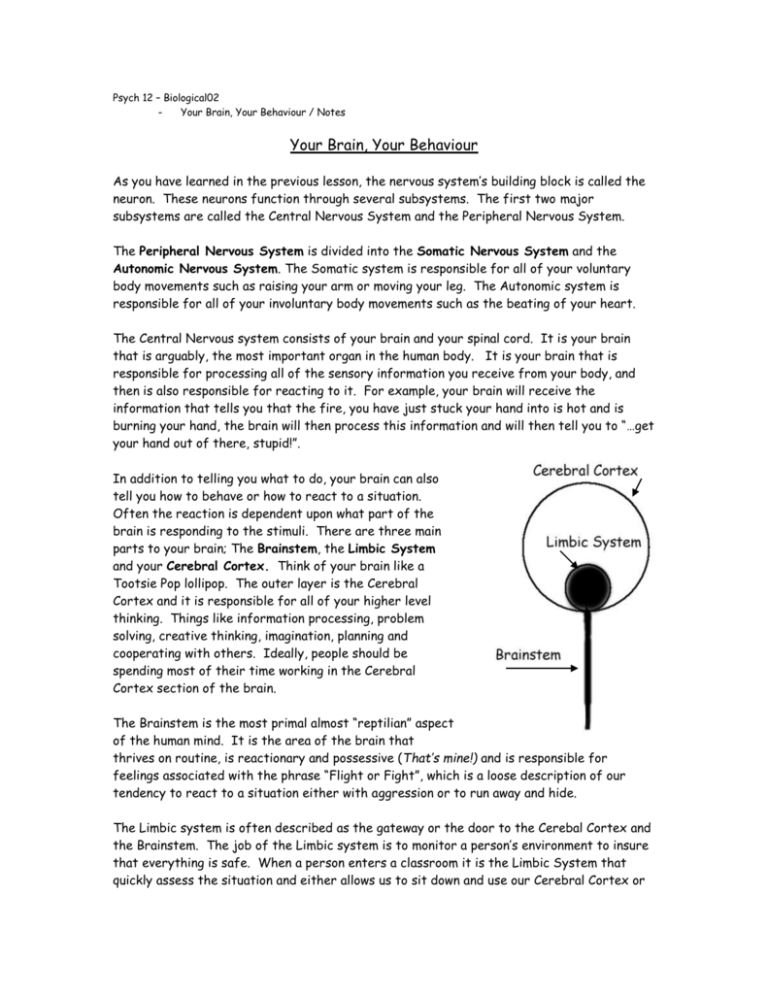
Psych 12 – Biological02 - Your Brain, Your Behaviour / Notes Your Brain, Your Behaviour As you have learned in the previous lesson, the nervous system’s building block is called the neuron. These neurons function through several subsystems. The first two major subsystems are called the Central Nervous System and the Peripheral Nervous System. The Peripheral Nervous System is divided into the Somatic Nervous System and the Autonomic Nervous System. The Somatic system is responsible for all of your voluntary body movements such as raising your arm or moving your leg. The Autonomic system is responsible for all of your involuntary body movements such as the beating of your heart. The Central Nervous system consists of your brain and your spinal cord. It is your brain that is arguably, the most important organ in the human body. It is your brain that is responsible for processing all of the sensory information you receive from your body, and then is also responsible for reacting to it. For example, your brain will receive the information that tells you that the fire, you have just stuck your hand into is hot and is burning your hand, the brain will then process this information and will then tell you to “…get your hand out of there, stupid!”. In addition to telling you what to do, your brain can also tell you how to behave or how to react to a situation. Often the reaction is dependent upon what part of the brain is responding to the stimuli. There are three main parts to your brain; The Brainstem, the Limbic System and your Cerebral Cortex. Think of your brain like a Tootsie Pop lollipop. The outer layer is the Cerebral Cortex and it is responsible for all of your higher level thinking. Things like information processing, problem solving, creative thinking, imagination, planning and cooperating with others. Ideally, people should be spending most of their time working in the Cerebral Cortex section of the brain. The Brainstem is the most primal almost “reptilian” aspect of the human mind. It is the area of the brain that thrives on routine, is reactionary and possessive (That’s mine!) and is responsible for feelings associated with the phrase “Flight or Fight”, which is a loose description of our tendency to react to a situation either with aggression or to run away and hide. The Limbic system is often described as the gateway or the door to the Cerebal Cortex and the Brainstem. The job of the Limbic system is to monitor a person’s environment to insure that everything is safe. When a person enters a classroom it is the Limbic System that quickly assess the situation and either allows us to sit down and use our Cerebral Cortex or tells us to either leave, or sit down at the back of the room and draw as little attention to ourselves as possible. Often if a student is bullied by a fellow classmate or is made to feel inferior by a teacher, the Limbic system shuts down the Cerebal Cortex and learning will cease to take place. However, if the student feels that the classroom is a safe, non-threatening environment, then the Limbic system will allow the student to relax and use their Cerebral Cortex to listen, think about and engage in the day’s lesson. Psych 12 – Biological02 - Your Brain, Your Behaviour Your Brain, Your Behaviour Directions: READ the excerpt from Psychology by David G. Myers, and the story of Phineas Gage from Psychology – An Introduction by Ben Lahey, and answer the following questions; 1. On a separate piece of paper, define the following terms; Electroencephalogram Thalamus Brainstem Cerebellum Reticular Formation 2. Answer the following questions using COMPLETE SENTENCES; a. In your own words, describe why you think we need to study the brain. (2 marks for quality of thought) b. In your own words describe the three ways in which we can study or “map” the brain using modern technology. (2 marks for your response and inclusion of details) c. In your own words, describe the brainstem, the limbic system, and the cerebral cortex. What are their roles and what do they do for us? (2 marks for quality of thought and inclusion of details) d. Using your own words, use the story Phineas Gage to describe how your brain and personality are linked. (2 marks for evidence of thought and effort) 3. Using the diagram found opposite, color and label the location of the several major functions of the left cerebral hemisphere. You will receive 5 marks for your completed, colored diagram. Total Marks:____/ 20 3. Using the diagram found below, color and label the location of the several major functions of the left cerebral hemisphere. You will receive 5 marks for your completed, colored diagram. Psych 12 – Biological02 - Your Brain Your Brain An excerpt from Psychology by David G. Myers In a jar on a display shelf in Cornell University’s psychology department resides the wellpreserved brain of Edward Bradford Titchener, a great turn-of-the-century experimental psychologist and proponent of the study of consciousness. Imagine yourself gazing at that wrinkled mass of grayish tissue. Is there any sense in which Titcherner is still in there? You might answer that without the living whir of electrochemical activity there could be noting of Titchener in his preserved brain. Consider then an experiment about which the inquisitive Titchener himself might have daydreamed. Imagine that just moments before his death, someone removed Titchener’s brain from his body and kept it alive by pumping enriched blood through it as it floated in a tank of cerebral fluid. Would Titchener now still be in there? Further imagine, to carry our fantasy to its limit, that someone transplanted the still-living brain into the body of a badly brain-damaged person. To whose home should the recovered patient return? That we can imagine such questions illustrate how convinced we are that we live in our heads. And for good reason: As Woody Allen has said, the brain is a very important organ. The brain makes possible the functions we attribute to the mind: seeing, hearing, remembering, thinking, feeling, speaking, and dreaming. But precisely where and how are such mind functions tied to the brain? Let us first see how scientists explore such questions. The Tools of Discovery It is exciting to consider how fast and far the neurosciences have progressed within a lifetime. For centuries, the human brain lay largely beyond the reach of science. The neuron is too small to study with the naked eye, its impulses too faint to record with ordinary electrodes. We were able to feel bumps ion the skull, dissect and analyze lifeless brains, and observe the effects of specific brain diseases and injuries. But there were no tools high-powered yet gentle enough to explore the living brain. Now, that has all changed. Whether in the interests of science or medicine, we can selectively destroy tiny clusters of normal or defective brain cells, leaving their surrounding unharmed. We can probe the brain with tine electrical pulses. We can snoop on the messages of individual neurons and on the mass action of billions. We can see color representations of the brain’s energy-consuming activity. These new tools and techniques have made possible a neuroscientific revolution. Clinical Observations The oldest method of studying brain/mind connections is to observe the effects of brain diseases and injuries. Such observations were first recorded some 5000 years ago. But it was not until the last two centuries that physicians began systematically to record the results of damaged to specific brain areas. Some noted that damage to one side of the brain often caused numbness or paralysis on the body’s opposite side. Others noticed that damage to the back of the brain disrupted vision, and that damage to the left front part of the brain produced speech difficulties. Gradually, crudely, the brain was being mapped. Manipulating the Brain Now, however, scientists need not wait for brain injuries to occur randomly. They can electrically stimulate the brain. Or they can surgically produce a brain lesion (destruction of tissue) in specific brain areas in animals. For example, a lesion in one well-defined region of a rat’s brain reduces eating, causing the rat to starve unless force-fed. Conversely, a lesion in a nearby area produces overeating. Recording the Brain’s Electrical Activity Modern researchers have also learned to eavesdrop on the brain. Modern microelectrodes have tips so small they can detect the electrical activity in a single neuron, making possible some astonishingly precise finding. For example, we can now detect exactly where the information goes after someone strokes a cat’s whisker. This electrical activity in the brain’s billions of neurons sweeps in regular waves across its surface. The electroencephalogram (EEG) is an amplified tracing of such waves by an instrument called an electroencephalograph. Studying an EEG of the gross activity of the whole brain is like studying the activity of a car engine by listening to the hum of its motor. However, by presenting a stimulus repeatedly and having a computer filter out electrical activity unrelated to the stimulus, one can identify the electrical wave evoked by the stimulus. Observing abnormalities in such brain-wave responses is an easy, painless way to diagnose certain forms of brain damage. Brain Scans Other new window into the brain give us a Supermanlike ability to see inside the brain without lesioning it. For example, the CAT (computerized axial tomograph) scan examines the brain by taking x-ray photographs that can reveal brain damage. Even more dramatic is the PET (positron emission tomograph) scan. A PET scan depicts the activity of different brain areas by showing each area’s consumption of its chemical fuel, the sugar glucose. Active neurons burn more glucose. When a person is given a temporarily radioactive form of glucose, the PET scan measures and locates the radioactivity, thereby detecting where this “food for thought” goes. In this way, researchers can see which brain areas are most active as the person performs mathematical calculations, listen to music, or daydreams. A new way of looking into the living brain exploits the fact that the centers of atoms, including those in our brains, spin like tops. In MRI (magnetic resonance imaging) the head is put in a strong magnetic field, which aligns the spinning atoms. Then a brief pulse of radio waves disorients the atoms momentarily. When the atoms return to their normal spin they release detectable signals, which are processed into computer-generated images of the concentrations of these atoms. The result is a detailed picture of the brain’s soft tissues. For example, MRI scans reveal enlarged fluid-filled areas in some patients suffering from schizophrenia, a disabling psychological disorder. These new tools have indeed triggered a scientific revolution, most of whose pioneers are still active. To be learning about the neurosciences now is like studying world geography while Magellan was exploring the seas. Every year the explorers announce new discoveries, which also generate new interpretations of old discoveries. Such times can be unsettling, but they are never dull. How the Brain Governs Behaviour Brain tool kit in hand, we are ready to explore. Opening the skull, the first thing we might notice is the brain’s size. In dinosaurs the brain represents 1/100,000th of the body’s weight, in whales, 1/10,000th, in elephants 1/600th, in humans 1/45th. It looks like a principle is emerging, but keep on. In mice the brain is 1/40 th the body’s weight and in marmosets 1/25th. So there are exceptions to the rule of thumb that the ratio of body weight provides a clue to a species intelligence. More useful clues to an animal’s capacities come from the brain’s structures. In primitive vertebrate (backboned) animals, such as sharks, the brain primarily regulates basic survival functions: breathing, resting and feeding. In lower mammals, such as rodents, a more complex brain enables emotion and greater memory. In advanced mammals, such as humans, the brain processes more information, enabling us to act with foresight. Roughly corresponding these three stages of brain evolution are three of the vertebrate brain’s principal layers – the brainstem, the limbic system, and the cerebral cortex. With the elaboration of each succeeding layer, tight genetic controls relax and the organism’s adaptability increases. Thus amphibians, such as frogs, have a small cortex and operate extensively on preprogrammed genetic instructions; the larger cortex of mammals offers increased capacities for learning and thinking, enabling them to be more adaptable. Brain evolution ahs not greatly altered the basic mechanisms for survival. Rather, as English neurologist John Hughlings Jackson recognized a century ago, evolution has added new brain systems on top of the old, much as the earth’s landscape covers the old with the new. Digging down, one discovers the fossil remnants of the past—brainstem components still performing much as they did for our distant ancestors. The Brainstem and Basic Survival The brainstem is the brain’s oldest and innermost region. It is therefore also called the “old brain” or “central core”. The brainstem begins where the spinal cord enters the skull and swells slightly, forming the medulla. Here lie the controls for your heartbeat and breathing. Here also is the crossover point, where most nerves to and from each side of the brain connect with the opposite side of the body. This peculiar cross-wiring is but one of many surprises the brain has to offer. Extending from the rear of the brainstem is the cerebellum, with its two wrinkled hemispheres. The cerebellum influences learning and memory, but its most obvious function is muscular control. On orders from the cortex, the cerebellum coordinates voluntary movement. If you injured your cerebellum, you would probably have difficulty walking, keeping your balance, or shaking hands. Your movements would be jerky and exaggerated. Atop the brainstem sits a joined pair of egg-shaped structures called the thalamus. This is the brain’s sensory switchboard: It receives information from the sensory neurons and routes it to the higher brain regions that deal with seeing, hearing tasting and touching. We can think of the thalamus as being to neural traffic what London is to England’s train traffic: Sensory input passes though it en route to various destinations. The thalamus also receives some of the higher brain’s replies, which it directs to the cerebellum and the medulla. Inside the brain stem, the reticular formation (also know as the reticular activating system) extends from the spinal cord right up to the thalamus. This finger-shaped network of neurons helps control arousal and attention. As the spinal cord’s sensory input travels up to the thalamus, some of it branches off to the reticular formation, which filters incoming stimuli and relays important information to other areas of the brain. In 1949, Giuseppe Moruzzi and Horace Magoun discovered that electrically stimulating the reticular formation of a sleeping cat almost instantly produce an awake, alert animal. Magoun also severed a cat’s reticular formation from higher brain regions without damaging the nearby sensory pathways. The effect? The cat lapsed into a coma from which it never awakened. Magoun could clap his hands in the cat’s ear, even pinch it; still no response. Under the influence of the cerebral cortex, the reticular formation controls not only arousal but also attention. While you are concentrating on this paragraph (or for that matter when you are asleep), you are, thanks to your reticular formation, less sensitive to the sound of someone talking nearby. IN the same way, a sleeping cat’s brain sorts through countless noises, blocking out the irrelevant ones and arousing the animal if it detects a significant sound. Our brain has the capacity to process information without conscious awareness. Remarkably, our brainstem manages these life-sustaining functions with little or no conscious effort. Whether you are asleep or awake, life functions go on, freeing the higher brain regions to dream, to think, to talk, to savor a memory. Living with a Hole in the Head – The Case of Phineas Gage Taken from Psychology – An Introduction By Ben Lahey In 1848 Phineas Gage was excavating rock to make way for a new section of track for the Rutland and Burlington Railroad in Vermont. Gage known as a reasonable, polite, and hardworking man, had been made a foreman by the railroad. On one particular afternoon in the fall, he was hard at work preparing to blast a section of rock when an accident happened. Gage was tamping blasting powder into a hole with a long tamping rod when a spark ignited the powder. The explosion shot the rod up through his upper left jaw and completely through his head. When Gage’s coworkers reached him, he was conscious and able to tell them what had happened. He was rushed to a physician who was able to stop the bleeding and save his life, but the destruction of such a large amount of brain tissue took a terrible toll on his emotions and intelligence. Gage became irritable, publicly profane, and impossible to reason with. He also seemed to lose much of his ability to think rationally and plan. As a result, he had trouble holding a job and was regarded as a “totally changed” man by his former friends. The case of Phineas Gage is surprising in part because he lived through his accident. It is highly unlikely that injuries to the brain as extensive as his could occur without destroying areas that are vital to survival. But the dramatic alteration in Gage’s personality is also impressive in what it reveals about behaviour. Even though his wounds healed, Gage’s brain never functioned in the same way again. Because brain and behaviour are inseparably linked, destruction of important parts of his brain led to destruction of important parts of his personality as well.
